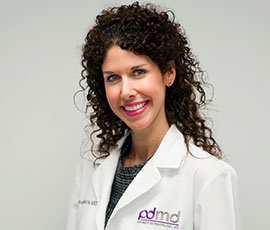Chicken skin
I gave my daughter a hug the other day, and my hand brushed on the back of her arms. And I felt the bumps. The same bumps that I have on the backs on MY arms. Some call it "chicken skin." Some call it "sandpaper arms." So what's the deal with these little white bumps?
Keratosis Pilaris (KP) is a very common condition that often starts in childhood. Anyone can get it, and it tends to happen more frequently in females. It can be associated with eczema, dry skin, and seasonal allergies (atopic dermatitis), or can be an isolated finding. It's caused by a buildup of keratin in the hair follicles, and is commonly located on the backs of the arms, inner thighs, and cheeks. Sometimes it can be found on the abdomen, back, buttocks, and legs, too. The condition often runs in families.
As keratosis pilaris is a benign condition, no treatment is needed. It usually gets better with age, especially after puberty, but it can persist into adulthood. There is no magic cure for KP. Emollients will often improve texture of the skin. Glycolic acid, lactic acid, and salicylic acid lotions, urea creams, retinoid creams, peels, and microdermabrasion are all treatments that may improve the appearance and feel of the bumps. One of my favorites is SkinMedica's AHA/BHA cream, available at pdmd. Picking is not recommended, as it can lead to scarring.
My daughter's got half my genetic makeup- the good, the bad, and the bumpy!
How to treat a sunburn
Pretty much everyone knows that getting a sunburn is a bad idea. Aside from being uncomfortable or downright painful, a sunburn accelerates the aging process and increases the risk of developing skin cancer, including melanoma. But occasionally, even to the most cautious people, it can happen. So what can be done to treat it?
Seek the shade
First and foremost, get out of the sun and into a cool, shady place to prevent any more damage at the first signs of a sunburn. Unfortunately, the redness and discomfort may not show up until a few hours after the burn.
Cool down
Cool showers, cool compresses, and slathering on moisturizing creams can help. Avoid scrubbing the skin. Eucerin calming cream can often feel soothing. The moisturizer can be kept in the refrigerator for added benefit. Taking ibuprofen or aspirin by mouth helps alleviate inflammation and pain. Remember, kids should never be given aspirin.
Hydrate
Drink lots of water to re-hydrate. Headache and dizziness can be a sign of dehydration. Children can dehydrate easily, so if they seem ill or develop fever, be sure to seek medical attention. Rarely, IV hydration may be needed.
Relieve the itch
Sunburned skin often feels itchy and tight. An over the counter hydrocortisone cream can offer some relief. If it doesn't do enough, a dermatologist can prescribe a stronger cream, or occasionally, oral steroids. Loose clothing will prevent further irritation of the skin from friction.
Hands off!
If it's a bad sunburn, blisters may develop. Avoid picking or peeling blisters or skin, as this can lead to infection. If many blisters or fever are present, see a physician pronto.
Avoid it
The best way to treat a sunburn is to avoid it in the first place. Limit time in the sun, wear sun protective clothing (shirts and hats), and slather on the sunscreen every two hours (more often if swimming or sweating). Remember, we only have one skin: protect it!
Lighten up
It's a common problem many battle every day - melasma. These brown patches usually show up on the forehead, cheeks, upper lip, and chin area. Women tend to be affected more often than men. No one knows exactly what causes it, but we do know that there are certain factors that seem to trigger the increase in pigmentation. Sun exposure and estrogen are the two biggies. Birth control pills, hormone replacement therapy, and pregnancy (in which case it is called chloasma, or the mask of pregnancy) rev up melanocytes to produce more melanin, which is responsible for pigment in the skin.
Melasma is a difficult condition to treat. Like many other conditions in dermatology (psoriasis, eczema, acne) there is no cure. A combination of topical medications and procedures are used to improve it, but results need to be maintained. The single most important factor is sun exposure. People with melasma MUST protect their skin from the sun. Sun avoidance, suncreen, sun protective clothing: the whole nine yards.
The gold standard in topical treatments is the lightening cream hydroquinone. This can be prescribed by a dermatologist and should be used under their supervision. A very rare complication of this cream is a condition called ochronosis, which results in darkening of the skin. Fortunately, this is not common. There are many other topical treatments available that do not contain hydroquinone. These are often used as well to treat melasma. These creams contain lightening ingredients such as azaleic acid, kojic acid, licorice, soy, lignin peroxidase, etc. One of my favorite non-hydroquinone containing creams is Lytera. Retinoids can help lighten dark spots as well. If the treatments are irritating, a topical cortisone is sometimes used.
In addition to topical treatments, light chemical peels can be performed in the doctor's office. However, care must be taken to avoid hyperpigmentation (darkening of areas). Lasers and light treatments, such as intense pulsed light, have been shown to be very effective for brown spots on the face and may improve melasma.
Just as exercise and diet are used to help maintain a healthy weight, strict sun protection and various dermatologist-prescribed treatments can help maintain beautiful skin.
Botox Myths
Hating the lines on your forehead but still hesitating to get Botox? Here's the skinny on one of my favorite beauty treatments.
"I'm afraid I'll look wierd."
With proper technique, a very natural, more youthful result can be achieved. Botox, Dysport, and Xeomin can smooth the "eleven" lines between the eyebrows, which make people appear angry, even when they're not. It can relax lines across the forehead, as well as crow's feet. It can stop wrinkles on the nose (bunny lines), a dimpled chin (golf ball chin), and tight neck bands. A board certified dermatologist with cosmetic experience has the training necessary for beautiful, natural, "non-wierd" results.
"I don't think it's safe."
Botox has been used in millions of patients worldwide for more than 20 years in the treatment of both medical and cosmetic conditions. While there are certain patients that should not have the treatment (those with an allergy to the product, certain neuromuscular conditions, those pregnant or nursing), when used correctly, it is overall a very safe treatment, with serious side effects being extremely rare.
"I don't want to look worse once it wears off."
The effects of Botox last about three months. It works by temporarily stopping the release of a chemical from nerves called acetylcholine which instructs muscles to contract. After a short period of time, the nerves begin releasing the chemical again, and the muscle will contract, just like they did before. Wrinkles will return to what they were before the treatment.
Botox injections are one of the most popular cosmetic procedures performed worldwide. With no cutting or downtime, a little can go a long way.
We are all beautiful
Today I was fortunate to be a part of the Dove Movement for Self-Esteem, where members of the Women's Dermatologic Society can reach out into the community to educate young girls and teens about skin care and promote positive self esteem. We met with young women ages 11-18 and had a discussion about what beauty means to them, how they feel when they see images of what "beauty" is in the media, what they would like the images to project instead, and how they feel about themselves.
In a world where we are constantly bombarded with photoshopped images of perfect, often unattainable and unrealistic ideas and images of beauty, it's so important to reinforce to our young women that real beauty is from within, and is made up of thoughts, actions, voices, and attitudes; not a lipstick color or hairstyle. We also talked about skin care and living a healthy lifestyle that includes eating foods rich in vitamins and minerals, sleeping enough hours at night, mindfulness, and exercise.
The program's vision is to "create a world where beauty is a source of confidence, not anxiety." Look in the mirror. You are real, and you are beautiful. Hug your sisters, daughters, mothers, friends. Let's encourage and empower each other as strong, powerful, healthy females. That's true beauty!

Categories
- November 2014 (1)
- December 2014 (3)
- January 2015 (4)
- February 2015 (3)
- March 2015 (1)
- April 2015 (3)
- May 2015 (4)
- June 2015 (2)
- July 2015 (0)
- August 2015 (1)
- September 2015 (2)
- October 2015 (4)
- November 2015 (1)
- December 2015 (1)
- January 2016 (2)
- February 2016 (1)
- March 2016 (3)
- April 2016 (2)
- May 2016 (1)
- June 2016 (1)
- August 2016 (1)
- October 2016 (1)
- January 2017 (1)
- February 2017 (1)
- June 2017 (1)
- August 2017 (1)
- October 2017 (1)
- December 2017 (1)
- April 2018 (1)
- May 2018 (1)
- November 2018 (1)
- May 2019 (1)
- July 2019 (1)
- January 2020 (1)
- March 2020 (2)
- July 2020 (1)
- November 2020 (0)
- January 2021 (1)
- October 2021 (1)
- January 2022 (1)
- June 2022 (1)
- November 2022 (1)
- April 2023 (1)
- September 2023 (1)
- September 2023 (1)
- December 2023 (1)
- February 2024 (1)
- July 2024 (1)
- September 2024 (1)
- March 2025 (1)
Archives
Latest on blog
No hair? Don't despair!
Published March 7th, 2025It happens to millions of women and men. It's so frequent, in fact, that there's a billion...
Learn More
